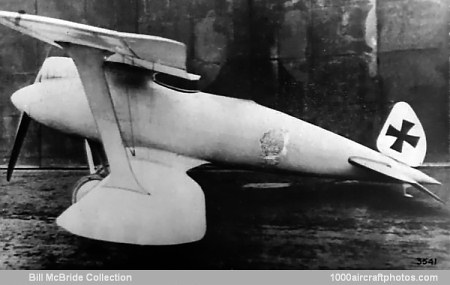01/31/2013. Late in 1916, the Rumpler team headed by Edmund Rumpler initiated design of both a two-seat and a single-seat fighter embodying a novel, if complex, method of fuselage construction. This, protected by a patent filed early in 1915, sought to combine minimum weight with maximum strength. The fuselage was built up from plywood frames with numerous thin stringers, the whole being covered by two layers of doped fabric strips applied diagonally in opposite directions and intended to provide the necessary torsional stiffness.
A close-cowled 160 hp Mercedes D III engine was attached to a fuselage extrusion supporting the upper wing, which embodied an offset flush radiator. The upper wing was of parallel chord, the lower wing being of so-called Libelle (Dragonfly) form featuring a curved trailing edge, the wing cellule being braced by single broad-chord I-section struts with cables running to two fuselage points. This formula, which resulted in what was, aerodynamically, an outstandingly clean aeroplane, was applied to the 7C 1 two-seat fighter and the 7D 1 single-seat fighter.
The 7C 1 entered flight test in the spring of 1917, initially with vertical tail surfaces confined to a pivoting rudder. The tail was subsequently redesigned to embody a fixed fin, but development was discontinued at a comparatively early stage, presumably as a result of difficulties similar to those experienced with the parallel single-seat 7D 1.
Evolved in parallel with the two-seat 7C 1 and embodying similar aerodynamic and structural features, the 7D 1 single-seat fighter was the recipient of an Idflieg contract for three prototypes, flight testing commencing in the spring of 1917. The Idflieg requirement called for a speed of 103 mph (165 kmh) at 16,405 ft (5,000 m), that altitude being attained in 31.5 minutes, and an endurance of 1.5 hrs.
An armament of two synchronized 0.311 in (7.9 mm) LMG 08/15 machine guns was specified and provision for oxygen breathing apparatus requested. A second identical prototype was designated 7D 2.
Flight testing revealed that the pilot's field of vision was seriously impaired by the broad-chord interplane struts and there were aerodynamic problems associated with the upper wing/fuselage junction. Furthermore, there were servicing difficulties related to the engine installation. In consequence, the 7D 1 and 7D 2 were abandoned in favor of a more conventional fighter, the 7D 3.
